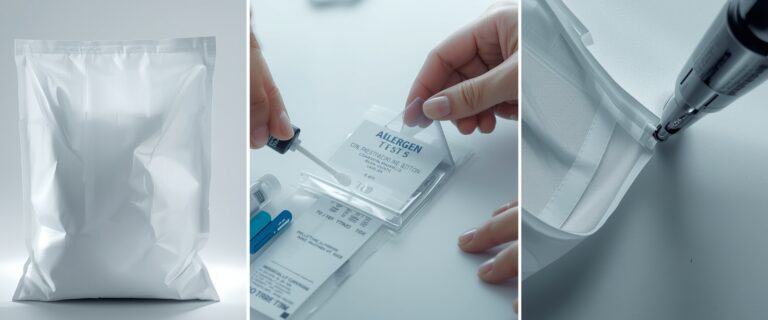
Not every Big Bag can be perfectly reconditioned with standard processes. That’s why we offer optional special solutions tailored to your exact needs. Whether it’s added protection with new liners, verified safety through allergen testing, or extending service life with minor repairs – we create the right solution for your industry and requirements.
All measures are, of course, carried out in compliance with applicable regulations, hygiene, and quality standards. This ensures that your Big Bags remain reliable, hygienic, and cost-efficient in use.
Where it makes sense
Liners (film inserts) protect both product and Big Bag from moisture, oxygen, dust, and cross-contamination. Depending on the medium, LDPE, LLDPE, HDPE, co-extruded, or aluminum composite liners are used. This allows barrier, antistatic, or conductive requirements to be met.
Our Procedure
Inspection of the FIBC type (A/B/C/D) and the ESD requirements of your process. For conductive applications, the liner must match the FIBC type (e.g., antistatic or conductive).
Visual and functional check of the Big Bags (seams, loops, fabric), including documentation of SWL/safety factor labeling.
Low-particle removal of the old liner, installation of the new liner (custom-fitted), followed by leak and strength testing.
Optional: labeling and batch tracking of the installed liner in the test protocol.
Why it matters
For sensitive industries such as food and pharmaceuticals, we test for residues of selected allergens to rule out cross-contamination after cleaning and to support your HACCP or QA compliance. Our work is based on established industry guidelines and validated testing methods.
Our Procedure (Screening/Verification)
Selection of relevant target allergens (based on the 14 EU allergens according to Regulation (EU) 1169/2011).
Swab or surface sampling of defined Big Bag zones, e.g., liners, seams, or discharge spouts.
Rapid tests (LFD) or ELISA analysis, depending on matrix and sensitivity.
Documentation with batch reference; repeat testing after corrective measures if required.
Notes & Limitations
Tests must be validated for the respective matrix; process parameters such as residual moisture or cleaning agents may affect results.
Screening is not a legal proof for placing food on the market but supports your internal approvals within HACCP, IFS, or BRC frameworks.
What we provide – with care
Replacement of non-load-bearing parts such as labels, tags, drawstring stoppers, or web ties.
Rejection or segregation in case of structural damage such as defective lifting loops, seams, or fabric tears.
Why this limit matters
Reconditioning is limited to labels, web ties, small parts, and liner replacement – but not load-bearing structures.
As a rule: in case of damage, manufacturer specifications and applicable standards must be followed.
Safety & Documentation
Every intervention is documented (SWL/SF, Type A–D, findings, measures, approval or rejection).
On request, photos and checklists can be integrated into your batch dossier.